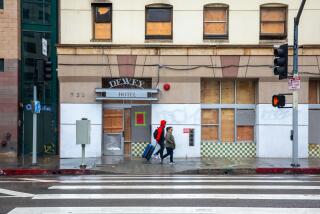Cleaning skid row, carefully
This week, city officials began a major cleanup of skid row’s streets and sidewalks. The goal is to rid the area of hazardous bulky items and material that has attracted vermin or otherwise poses a threat to public health and safety. So far — and its only been two days — the city appears to be running this project carefully and thoughtfully.
Officials had said their ability to clean the streets was limited by a 2011 federal court injunction barring the city from seizing the unattended belongings of the homeless on skid row. As this cleanup continues, we expect the city to comply with that ruling while carrying out its responsibility to remove objects and waste that endanger everyone.
The city has rightly made it an elaborate undertaking, sending homeless advocates out a few days ahead of the cleaning crew to alert people living on the streets that they will have to leave, taking their belongings, on the day of the work — and offering to help them get shelter and other services if they choose. The blocks are then cordoned off so workers in protective gear can pressure wash the streets and remove any items that have been left behind. When the cleaning is finished, people are allowed to return to the area.
On the first day of the project, sanitation workers disposed of a mattress, dirty blankets and clothing, and enough hypodermic needles to fill a bucket. Found jewelry was bagged, identified and taken to a storage facility, according to Patrick Butler, an assistant chief of the Los Angeles Fire Department who is helping coordinate the city task force conducting the cleaning. Signs were later posted explaining where belongings had been taken.
Some homeless advocates are concerned that city workers are too industriously disposing of items that should be stored instead, but they agree that the city has the right — and the responsibility — to clean the streets to ensure public health and safety.
Of course it can be a difficult call for city workers to decide whether something is unsafe trash or a homeless person’s treasured possession. In making that decision, health must be the priority. Observers — reporters or advocates, for instance — should be able to stand nearby to watch without interfering with the cleaning process.
This summer cleaning is a welcome start. After years of rocky relations, we’re pleased to see city officials interacting more sensitively with people who on live on skid row. Now, what we’d really like is to get the homeless off the streets altogether and into the housing and service programs they desperately need.
More to Read
A cure for the common opinion
Get thought-provoking perspectives with our weekly newsletter.
You may occasionally receive promotional content from the Los Angeles Times.






